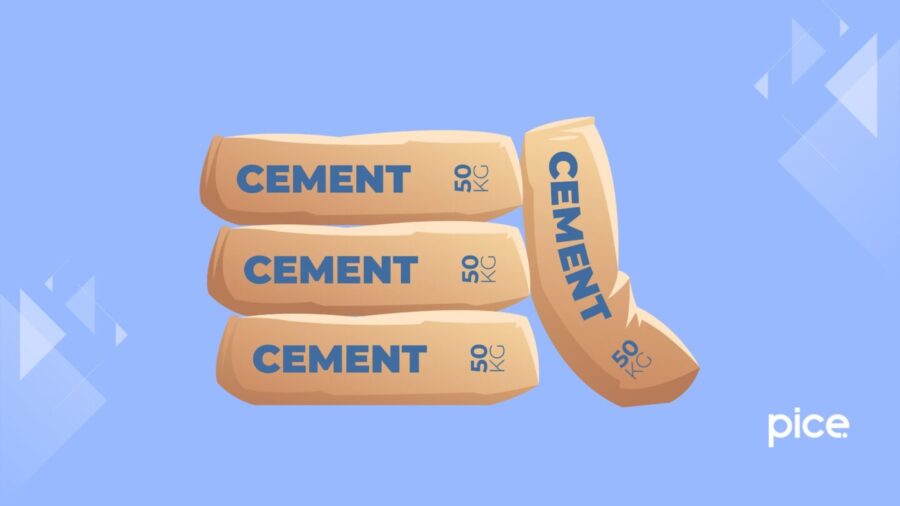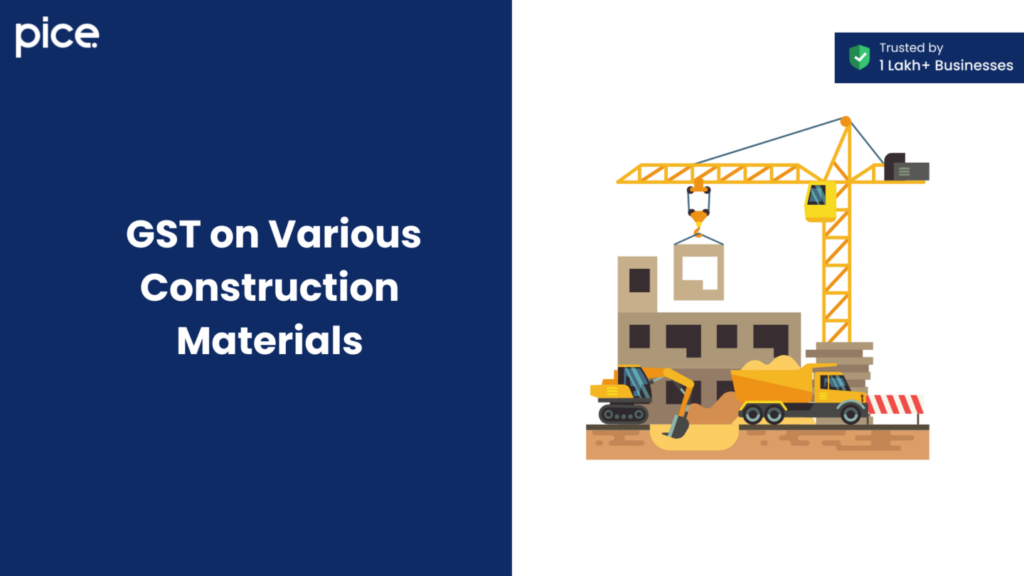GST on Cement
- 2 Sep 24
- 13 mins

GST on Cement
Key Takeaways
- The 28% GST rate on cement has significantly increased the cost of production and pricing in the market.
- GST has simplified tax compliance but also introduced challenges with higher costs in the cement sector.
- Transportation and warehousing efficiencies have improved under GST, reducing logistical bottlenecks for cement manufacturers.
- Input Tax Credit (ITC) management is crucial for cement companies to optimize costs under the GST regime.
- The high GST rate on cement affects affordability in the real estate and infrastructure sectors.
Presently, India is the second-largest producer of cement and one of the leading exporters of cement. This implies that with the implementation of GST as a unified taxation system in the country, there has been a notable impact on the cement industry as well. Since the price of cement has a notable effect on housing costs, it is essential to know about the taxes associated. Read on to learn about the cement GST rate and other crucial details associated with it.
Understanding GST on Cement
The GST laws highlight that you will need to pay 28% GST on cement. The high rate of GST is due to the increasing costs in the infrastructure sector. Before the introduction of GST, manufacturers needed to pay multiple taxes. This made it difficult for many manufacturers to pay the taxes on time.
In such scenarios, the factors on which the tax amount depends include cement type, trade or industrial purposes and form of trade. Under the old tax regime, manufacturers had to pay VAT around 24-25%. These factors amounted to a substantial amount of taxes.
However, with the introduction of GST, the tax rates applicable on cement and related products include:
- Cement-bonded particle boards: 12%
- Coal: 5%
- Limestone: 5%
- Concrete cement and mortar: 18%
There are several notable effects of the implementation of GST laws in the cement industry that you can witness.
💡 If you want to pay your GST with Credit Card, then download Pice Business Payment App. Pice is the one stop app for all paying all your business expenses.
Effects of GST on the Cement Industry
The introduction of GST left a notable impact on the cement industry. Following are the effects on the cement industry that are prominently visible:
- Transportation Costs Savings
The presence of cement manufacturing units near limestone quarries has resulted in increased transportation costs. Nonetheless with the implementation of GST, the number of checkpoints present in the transportation of cement reduced significantly, resulting in streamlining the entire process. Moreover, the overall costs of transportation of cement were reduced after GST implementation.
- Simplification of Tax Payments
Previously, manufacturers had to navigate through various taxes such as excise duty, service tax, etc. during the transaction of cement. Some of the factors that affected the payments of these taxes include trade or industrial purposes, bulk or packaged transportation and more. However, after the implementation of GST, manufacturers have to pay taxes at the rate of 28%, simplifying the overall tax structure.
- Warehousing Implications
Prior to the introduction of GST, manufacturers had to maintain multiple warehouses in the state to avoid the payment of state-entry taxes. However, they mostly operated below the available capacity. With the implementation of GST laws, the need to maintain multiple warehouses in the same cities reduces. Thus, manufacturers can maintain warehouses in their preferred locations that are easily accessible, making supply chains more cost-effective.
- Increased Cost of Components
After the implementation of GST laws, the total taxes that you will need to pay have increased to 28%. Additionally, you will have to pay 5% GST on coal and 5% GST on limestone transactions. However, coal comes under a clean energy cess, implying that you cannot claim an Input Tax Credit on it.
There is a simple way in which you can calculate the amount that you will have to pay as GST during the manufacture of certain products. Let us find out how.
Calculating GST on Cement
The GST laws indicate the applicability of a 28% tax on cement, irrespective of the materials it is made of such as slag, aluminous, super sulphate, or Portland cement. Apart from this amount, manufacturers do not need to pay any extra charges in the form of excise duty, etc. that previously existed. Thus, it has become simpler to calculate and determine the total amount that you will have to pay as taxes upon the supply of cement.
However, you will need to note that there is an additional cess of 12% that you will have to pay on cement products. Thus, the total taxes applicable on cement products amount to 31.36% (28% + (12% of 28%)). Here is an illustration of the calculation of GST on cement for your ease of understanding:
The formula to calculate GST on cement is as follows:
GST Amount = (Original Cost * GST Rate) / 100
Say suppose, the cost of cement is ₹1,000 per bag. Then you can calculate the total GST to be paid as:
GST Amount = (1,000 * 31.36) / 100 = ₹313.60
Thus, the overall amount that you will have to pay for the purchase is ₹(1,000 + 313.60), that is, ₹1,313.60.
Additionally, you should know about the appropriate GST rate on different construction materials to pay the total amount.
GST on Various Construction Materials

The GST rate varies with different construction materials. Following are the GST rates on the commonly available and used construction materials:
- GST Rate on Sand
The GST rate applicable on natural sand of various kinds except for metal-bearing sand is 5%. On the contrary, sand composed of bituminous or oil shale and tar, natural asphaltites, bitumen and asphalt and asphaltic rocks is subject to 18%.
- GST Rate on Bricks
You must pay 5% GST on building bricks, fossil bricks and other siliceous earth or fly ash bricks. However, as of April 2022, the rate of GST on bricks hiked to 12% along with the availability of Input Tax Credit benefits.
Furthermore, ceramic goods and refractory bricks attracted a GST of 18%, whereas, artificial stone, concrete cement, building blocks, cemented bricks, flagstones, and other materials of cement attracted a GST rate of 28%.
- GST on Marble and Granite
Usually, the GST rate applicable on granite blocks and marble blocks is 12%. However, granite, marble and travertine (not in blocks) attract a GST rate of 28%. Hence, you should thoroughly compare the pros and cons and discuss them with your architect to make the right purchase and save on costs.
- GST Rate on Building Stone
The GST laws state that you will have to pay 5% GST on gravel, pebbles and crushed stones used in concrete. Again, you can use the above-stated GST calculation formula to easily determine the total amount to be paid.
- GST Rate on Tiles
Different types of tiles attract varied GST rates. The tax rate for earthen or roofing tiles is 5% whereas that on bamboo flooring tiles is 18%. Furthermore, cement tile, tiles, concrete tile, artificial stone tile, ceiling coverings of plastics, floor coverings of plastics, boards, blocks, etc. attract a GST rate of 28%.
- GST Rate on Paints and Varnishes
For paints, varnishes, caulking compounds, painters’ fillings, enamels, resin cement, etc. you will need to pay a GST of 28%.
There are several ways in which the GST laws impact the supply chain of cement-based products in India.
Impact of GST on Cement Manufacturing Companies
The introduction of GST laws has had a notable impact on the functioning of top-rated cement manufacturing companies. This unified tax system resulted in fewer complexities when navigating through taxes, establishing an efficient and transparent tax regime.
Furthermore, it freed the companies from the cascading effect of tax, minimising the overall effect of the tax burden. Thus, GST gives a free hand to manufacturing companies to lower the cost of cement-based products, making it an affordable option among consumers.
The only challenge that the GST introduction brought with itself for cement manufacturing companies is the mandate to stay compliant with the laws associated. They need to complete registration, pay taxes and file returns on time to avoid legal complications.
Let us take the example of Ultratech Cement Ltd to understand how the popular companies reacted to this tax regime. As it is already known, Ultratech Cement Ltd is one of the leading and largest manufacturers of grey and white cement and mixed concrete in India.
Even globally, it leads as a cement manufacturer by exporting more than 2.5 million tonnes per annum, which happens to be 30% of India’s total exports. Several countries in Europe, Africa, and the Middle East are the top importers of Ultratech Cement Ltd.
Due to the lowering of the GST rate on cement, the cost of cement-based products that the company manufactured also reduced by 2% to 3%. This step resulted in an increased demand for cement products from Ultratech Cement Ltd. which is supplied to the real estate and infrastructure industry.
Furthermore, you should also be aware of the overall impact of GST on the real estate industry by getting an overall idea of the current market scenario such that you can easily plan the supply chain.
Overall Impact of GST on the Real Estate Industry
The introduction of Goods and Services Tax (GST) has left a lasting impact on the real estate industry. Some of the visible impacts of introduction of GST include:
- Reduction in taxes: To facilitate affordable housing, the government has reduced the taxes from 8% to 1%. For housing projects, the taxes were reduced from 12% to 5%. This reduction in the GST rates has made homes immensely affordable, boosting the demand among homebuyers.
- Discontinuation of ITC: The government abolished the availability of Input Tax Credit on various construction-related products. This led to an increase in the cost of construction costs, leaving a lasting impact on the profits earned by the real estate developers.
- Enhanced compliance: It is mandatory to comply with the laws associated with GST. Some of the essential GST regulations include filing of returns, GST regulations, and payment of taxes. This has become burdensome for various developers as non-compliance to these laws can lead to severe consequences.
Final Word
The cost of cement is on the verge of rising since the cement GST rate is on the higher side as well as based on the current market trends. This indicates that the price of houses might also increase, resulting in enhanced prices of housing. So, it would be prudent to plan the construction materials in a manner that would help in minimising costs as much as possible.
 By
By 

















